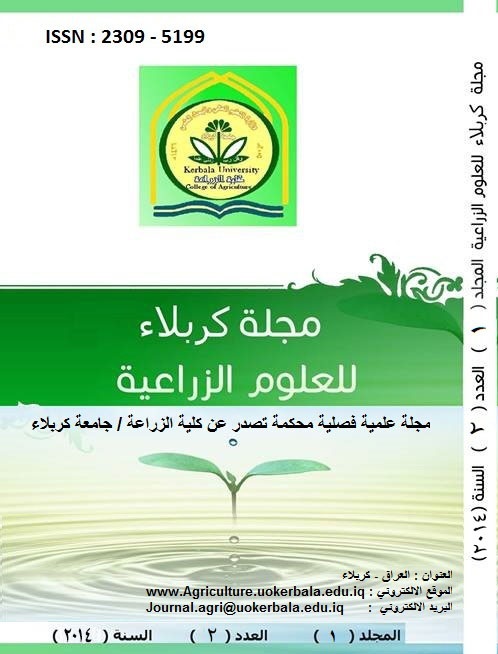Moisture content and agricultural implement weight effect on soil compaction with depth
DOI:
https://doi.org/10.59658/jkas.v1i2.346Keywords:
Soil compaction, agricultural implements , bulk density, penetration resistance, saturated hydraulic conductivityAbstract
Afield experiment was conducted to determine the compaction resulted in clay loam soil in terms of , bulk density , penetration resistance and saturated hydraulic conductivity at soil depths, (0-10, 10-20 , and 20-30 cm) under the effect of gravimatric moisture contents, (23.05 , 20.57 and 18.57%) and three agricultural implements defferent with type , equipping and total weight (tare + input) , hanging fertilizer spreader (300) kg , fogger (1290) kg and transport wagon (3600) kg . The last two implements as a towed with one axle . Each of above implements represent a compaction load. Compaction treatments were corried out using a wheeled tractor of 2750 kg , run once with each of implement behind it at all moisture contents , in addition to non tracked treatment (control) . The towed implement wheels were positioned to follow tractor wheels . All determination were taken beneath the track center line .
The results show that a great compaction occurred within 0-30cm soil depth , due to transport wagon at 23.05% moisture content ,bulk density and saturated hydraulic conductivity values were 1.56 Mg.m-3 and 4.04 mm.h-1 respectively. Exception control treatment, a lower compaction at the same depth above occurred under influence off fertilizer spreader at 18.57% water content, the values of the two soil properties mentioned above (1.39 Mg . m-3 and 36.36 mm.h-1 respectively).
The soil within 20-30cm depth was affected significantly by compaction of all implements and moisture content treatments exception fogger and fertilizer spreader at 18.57% moisture content treatments .A higher penetration resistance(2127kPa) was found at soil within 0-30cm depth under influence of transport wagon at 18.57% moisture content.
Downloads
Published
How to Cite
Issue
Section
License
Copyright (c) 2014 Copyright (c) 2024 is the Author's article. Published by the Journal of Kerbala for Agricultural Sciences under a CC BY 4.0 license

This work is licensed under a Creative Commons Attribution 4.0 International License.
Licensing Terms
All articles are published under a Creative Commons License and will be directed to the Creative Commons Attribution 4.0 International License (CC BY 4.0) That permits use, distribution, and reproduction in any medium, provided the original work is properly cited. This license also allows the work to be used for commercial purposes.
Use by both non-commercial and commercial users
This content is licensed under a Creative Commons Attribution 4.0 International (CC BY 4.0) license, permitting use by both non-commercial and commercial users. Individual users may access, download, copy, display, and redistribute the articles to colleagues, as well as adapt, translate, and text- and data-mine the content, subject to the following conditions:
- The author's moral rights, including the right of attribution and the right to protect their work from derogatory treatment, are respected.
- Where content in the article is identified as belonging to a third party, users must ensure that any reuse complies with the copyright policies of the owner of that content.
- If the article content is reused for research or educational purposes, users should maintain a link to the appropriate bibliographic citation, including the DOI and a link to the published version on the journal's website.

